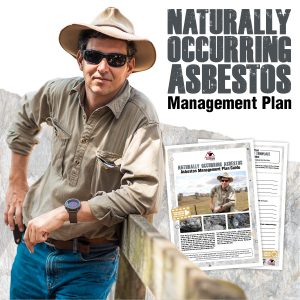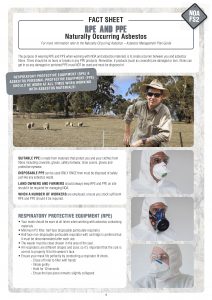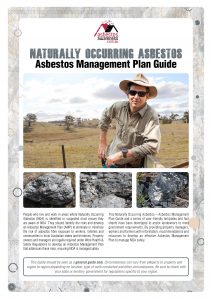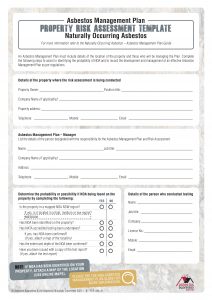
Asbestos is a group of minerals that readily separate into long flexible fibres. It occurs naturally in some rocks, sediments and soils globally and throughout Australia.
Known as Naturally Occurring Asbestos or NOA, it’s found in some rocks, sediments and in soils and is not easily identified. Asbestos in its natural form can be blue (crocidolite), brown (amosite), green (anthophyllite, tremolite and actinolite) or white (chrysotile, tremolite and actinolite).
Asbestos was mined for the manufacture of multiple products (OVER 3000) commonly used in homes, commercial properties, sheds and farm buildings because it was cheap, durable, flexible, and was a naturally insulating and fireproofing material. However, because asbestos fibres were proven to cause cancers and other lung diseases, a complete ban on asbestos came into force in Australia on 31 December 2003.
Only testing by a National Association of Testing Authorities (NATA) accredited laboratory, of a sample collected by a competent person, can confirm the presence of asbestos in any workplace including in building materials or in its natural forms in the environment.
IMPORTANT: In its natural state, asbestos presents the same health risks as asbestos contained in building products and other asbestos-containing materials.
Quick Links – Find Out More About NOA in NSW
- NOA in NSW Map to access the online map
- Visit SafeWork NSW for more information about NOA, regulations and Codes of Practice for Asbestos Management or call 13 10 50.
- Visit the NSW Environment Protection Authority for regulations about asbestos disposal of NOA or call 131 555
- Hotline: 1800 Asbestos (1800 272 378) provides free advice and guidance on asbestos-related issues in NSW and is operated by the SafeWork NSW Customer Contact Centre.
Resources for Property Owners to Manage NOA in Australia
NOA can be found in rocks, sediments and soils in various parts of Australia. While not all states and territories have developed specific NOA guidelines and controls for property owners and manager, the resources commissioned by the NSW Government may be useful in managing NOA in all parts of Australia as long as they are applied in accordance with local regulations.
Managing NOA in NSW in Accordance with Health & Safety Regulations
In 2017, Australia’s first comprehensive guide to managing NOA was commissioned to assist councils and property owners in preventing and minimising exposure to NOA on their properties and farms.
In NSW, blue and brown asbestos are not common and less than one percent of land is believed to contain NOA within 10 metres of the ground’s surface. However, property owners and managers are legally required under the NSW Work Health & Safety Regulations 2017 to develop an Asbestos Management Plan that addresses the risks, ensuring NOA is managed safely.
Naturally Occurring Asbestos – Asbestos Management Plan Guide
The Naturally Occurring Asbestos – Asbestos Management Plan Guide and a series of user-friendly templates provides property managers, workers and farmers with information, recommendations and resources to develop an effective Asbestos Management Plan to manage NOA safely on properties where it may be present in line with government regulations.
The Guide provides step-by-step instructions on how to determine if a property is located in a NSW region where naturally occurring asbestos may be present. It also contains information on how to conduct a risk assessment, testing, training requirements for workers, safe work procedures and control measures, and disposal.
People who live and work in rural and regional NSW where NOA is known or suspected, must ensure they’re aware of NOA to prevent disturbing asbestos in its natural state and risking exposure to asbestos fibres. It’s vital that property owners, managers and workers who may disturb the ground surface in their day-to-day work, identify the risks and develop an asbestos Management Plan (AMP) in accordance with regulations to eliminate or minimise the risk of asbestos fibre exposure to workers, families and communities.
NSW Naturally Occurring Asbestos – Asbestos Management Plan Guide
- NSW: Digital PDF with Links Download Size 6MB
- NSW: Offset Printing with crop marks Download Size 28MB
Managing NOA in States Other than NSW
 While the NOA Guide was developed for use by people living in NSW, the practices the Guide recommends in establishing and maintaining a NOA Asbestos Management Plan may also be appropriate for use in any community where NOA has been identified or is suspected.
While the NOA Guide was developed for use by people living in NSW, the practices the Guide recommends in establishing and maintaining a NOA Asbestos Management Plan may also be appropriate for use in any community where NOA has been identified or is suspected.
Generic versions of the Naturally Occurring Asbestos – Asbestos Management Plan Guide and templates were created for reference by people living and working in states other than NSW.
If you live in a state or territory other than NSW, contact your regulator to ensure NOA is managed in accordance with regulations.
Generic Naturally Occurring Asbestos – Asbestos Management Plan Guide
- GENERIC: Digital PDF with Links Download Size 6M
- GENERIC: Offset Printing with crop marks Download Size 28MB
Key Facts About Naturally Occurring Asbestos (NOA) in NSW
- Asbestos is a group of minerals that readily separate into long flexible fibres.

- It occurs naturally in some rocks and sediments in various regions in NSW.
- NOA can be blue (crocidolite), brown (amosite), green (anthophyllite, tremolite and actinolite) or white (chrysotile, tremolite and actinolite).
- Blue and brown asbestos are not common in NSW.
- NOA can be found in some rocks, sediments and in soils and is not easily identified.
- Less than 1% of land in NSW is believed to contain NOA within 10 metres of the ground’s surface.
- Only testing of a sample collected by a competent person conducted by a National Association of Testing Authorities (NATA) laboratory, can confirm the presence of asbestos in any workplace including in building materials or in its natural forms in the environment.

- People who conduct work or activities on properties, where NOA is identified or is suspected are legally required to develop an Asbestos Management Plan under the NSW Work Health & Safety Regulations 2017.
- By identifying the potential for the occurrence of NOA people can determine the risks, control measures and the levels of controls required to manage it safely.
- If stable, covered and undisturbed, it is believed that NOA doesn’t pose a risk to health.
- NOA can become a health risk if weather conditions or work that may be undertaken (such as digging, cultivation and excavation) disturbs NOA and releases fibres that can be inhaled.
About The Naturally Occurring Asbestos – Asbestos Management Plan Guide
To assist landowners to understand NOA and manage it in accordance with regulations, the NSW Government commissioned a series of useful online tools including the Naturally Occurring Asbestos – Asbestos Management Plan Guide.
The Guide Includes:
- What landowners need to know about NOA
- When NOA is a potential risk
- How to know if an Asbestos Management Plan for NOA is required
- The steps to take to develop an Asbestos Management Plan
- How to conduct a Risk Assessment for NOA
- Safe work procedures and control measures for NOA
- Useful resources and contact details for advice and information.
- Download the NSW Naturally Occurring Asbestos – Asbestos Management Plan Guide
- Download the Generic Naturally Occurring Asbestos – Asbestos Management Plan Guide
NOA Templates and Fact Sheets Include:
- Asbestos Management Plan – Property Risk Assessment Template
- Asbestos Management Plan – Site Specific Template
- Incident Procedures & Report – Template
- Workers Training Requirements & Records – Template
- NOA RPE & PPE – FACT SHEET
- NOA Decontamination – FACT SHEET
- DOWNLOAD TEMPLATES
DOWNLOAD ALL NOA DOCUMENTS
Share this information on:



